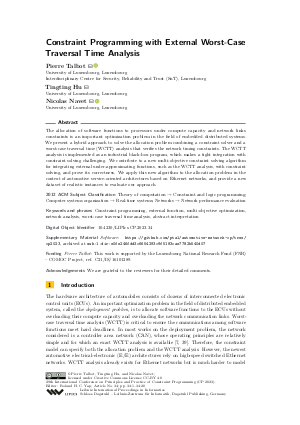@InProceedings{talbot_et_al:LIPIcs.CP.2023.34,
author = {Talbot, Pierre and Hu, Tingting and Navet, Nicolas},
title = {{Constraint Programming with External Worst-Case Traversal Time Analysis}},
booktitle = {29th International Conference on Principles and Practice of Constraint Programming (CP 2023)},
pages = {34:1--34:20},
series = {Leibniz International Proceedings in Informatics (LIPIcs)},
ISBN = {978-3-95977-300-3},
ISSN = {1868-8969},
year = {2023},
volume = {280},
editor = {Yap, Roland H. C.},
publisher = {Schloss Dagstuhl -- Leibniz-Zentrum f{\"u}r Informatik},
address = {Dagstuhl, Germany},
URL = {https://drops.dagstuhl.de/entities/document/10.4230/LIPIcs.CP.2023.34},
URN = {urn:nbn:de:0030-drops-190713},
doi = {10.4230/LIPIcs.CP.2023.34},
annote = {Keywords: Constraint programming, external function, multi-objective optimization, network analysis, worst-case traversal time analysis, abstract interpretation}
}

 Creative Commons Attribution 4.0 International license
Creative Commons Attribution 4.0 International license





